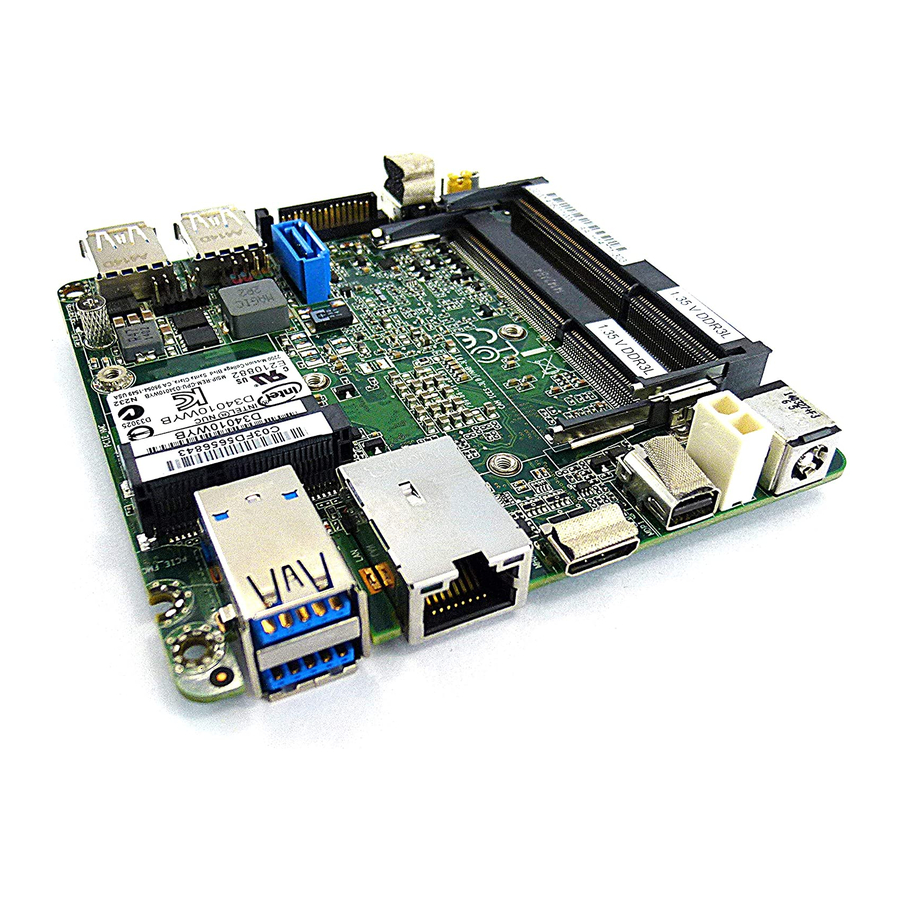
Table of Contents
Advertisement
Intel® NUC Board D54250WYB and
Intel® NUC Board D34010WYB
Technical Product Specification
October 2013
Order Number: H18263-002
Intel® NUC Board D54250WYB and Intel® NUC Board D34010WYB may contain design defects or errors known as errata that may cause the product to deviate
from published specifications. Current characterized errata are documented in Intel NUC Board D54250WYB and Intel NUC Board D34010WYB Specification
Update.
Advertisement
Table of Contents

Summarization of Contents
Intel NUC Product Description
1.1 Overview
Provides a general overview of the product's features and specifications.
1.1.1 Feature Summary
Summarizes the major features of the Intel NUC Boards D54250WYB and D34010WYB.
1.1.2 Board Layout (Top)
Illustrates the location of major components on the top side of the Intel NUC board.
1.1.3 Board Layout (Bottom)
Shows the location of major components on the bottom side of the Intel NUC board.
1.1.4 Block Diagram
Presents a block diagram of the major functional areas of the Intel NUC board.
1.2 Online Support
Offers links to find information and support resources for Intel NUC boards.
1.3 Processor
Details the Intel Core i5 and i3 processors used in the NUC boards.
1.4 System Memory
Describes the board's memory features, including supported SO-DIMM configurations.
1.5 Processor Graphics Subsystem
Covers the graphics capabilities provided by the Intel HD Graphics processor.
1.6 SATA Interface
Explains the board's SATA interfaces, including mSATA and SATA 6.0 Gb/s.
1.7 Real-Time Clock Subsystem
Details the real-time clock and CMOS memory powered by the coin-cell battery.
1.8 Audio Subsystem
Lists the features supported by the audio subsystem, including analog and digital audio.
1.9 LAN Subsystem
Describes the components and features of the Intel Gigabit Ethernet LAN subsystem.
1.10 Hardware Management Subsystem
Explains hardware management features like thermal and voltage monitoring.
1.11 Power Management
Details how power management is implemented, including ACPI and system states.
Intel NUC Technical Reference
2.1 Memory Resources
Discusses the system memory address space and its allocation for critical functions.
2.2 Connectors and Headers
Describes the board's connectors and headers, categorized by panel and on-board types.
2.2.1 Front Panel Connectors
Shows the location and types of connectors on the front panel of the board.
2.2.2 Back Panel Connectors
Illustrates the location and types of connectors on the back panel of the board.
2.2.3 Header (Top)
Identifies the location of specific headers found on the top side of the board.
2.2.4 Connectors and Headers (Bottom)
Shows the locations of various connectors and headers on the bottom side of the board.
2.2.4.1 Signal Tables for the Connectors and Headers
Provides detailed pinout signal tables for various board connectors.
2.3 BIOS Security Jumper
Explains the function and settings of the 3-pin BIOS security jumper.
2.4 Mechanical Considerations
Covers mechanical aspects such as the board's form factor and dimensions.
2.5 Electrical Considerations
Addresses electrical aspects including power supply options and fan header capabilities.
2.6 Thermal Considerations
Provides guidance on thermal management, airflow, and component temperature limits.
2.7 Reliability
Presents information regarding the Mean Time Between Failures (MTBF) prediction.
2.8 Environmental
Lists the environmental specifications for the Intel NUC board.
Overview of BIOS Features
3.1 Introduction
Introduces the Intel Visual BIOS, its storage, and update methods.
3.2 BIOS Flash Memory Organization
Details the structure and size of the BIOS flash memory device.
3.3 System Management BIOS (SMBIOS)
Explains SMBIOS for managing computers and obtaining system information.
3.4 Legacy USB Support
Describes USB device support enabling use before OS drivers are available.
3.5 BIOS Updates
Outlines the utilities and procedures for updating the system's BIOS.
3.6 BIOS Recovery
Lists acceptable drives and media types for performing BIOS recovery.
3.7 Boot Options
Explains how to configure boot devices and select boot options.
3.8 Hard Disk Drive Password Security Feature
Details the feature for securing hard disk drives with passwords.
3.9 BIOS Security Features
Covers BIOS features that restrict access to setup and computer booting.
Error Messages and Blink Codes
4.1 Front-panel Power LED Blink Codes
Explains error messages indicated by front panel power LED blink patterns.
4.2 BIOS Error Messages
Lists common BIOS error messages and provides brief explanations for each.
Regulatory Compliance and Battery Disposal
5.1 Regulatory Compliance
Provides regulatory compliance information for the Intel NUC boards.
5.1.1 Safety Standards
Lists the safety standards that the board complies with when installed correctly.
5.1.2 European Union Declaration of Conformity Statement
Declares the product's conformity with EU directives for CE marking.
5.1.3 EMC Regulations
Details the Electromagnetic Compatibility (EMC) regulations and standards compliance.
5.1.4 e-Standby and ErP Compliance
Covers compliance with e-Standby and EU Energy-related Products (ErP) directives.
5.1.5 Regulatory Compliance Marks (Board Level)
Shows and describes the various regulatory compliance marks present on the board.
5.2 Battery Disposal Information
Provides crucial warnings and guidance on the proper disposal of batteries.








Need help?
Do you have a question about the D54250WYK and is the answer not in the manual?
Questions and answers